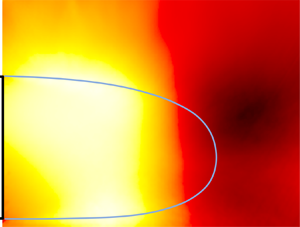Article contents
Manipulation of three-dimensional asymmetries of a turbulent wake for drag reduction
Published online by Cambridge University Press: 04 February 2021
Abstract

Combinations of passive and active flow control are used to reduce the aerodynamic drag of a three-dimensional blunt body by manipulating its large-scale wake asymmetries. An Ahmed-like body with a square-back is mounted in ground proximity in the test section of a wind tunnel to produce a canonical turbulent wake at  $Re_H = 5 \times 10^5$ based on the height
$Re_H = 5 \times 10^5$ based on the height  $H$ of the body. By using passive perturbations around the model, the large-scale asymmetry and dynamics of the unforced recirculation region are modified. Depending on the unforced wake equilibrium, additional high-frequency pulsed blowing, coupled with small curved deflecting surfaces along selected edges of the base, produces a very different impact on the drag. On the one hand, forcing the wake along all edges results in important drag reduction of up to 12 % through a wake-shaping mechanism with weak influence on the large-scale asymmetry. On the other hand, the reorganization of the recirculation region equilibrium plays a key role in the observed drag changes when the wake is only forced along some edges of the base. In particular, the symmetrization of the mean wake and the influence of forcing on the interaction mechanism between facing shear layers described by Haffner et al. (J. Fluid Mech., vol. 894, 2020, A14) appears to be one of the main mechanisms involved in drag reduction. Even if asymmetric forcing strategies resulting in symmetrization of the mean wake provide more modest drag reductions of up to 7 % compared with forcing around the whole base, they are more efficient from an energetic point of view. This study provides key ingredients to adapt forcing strategies for drag reduction in the presence of various wake asymmetries typically imposed in real flow conditions around ground vehicles.
$H$ of the body. By using passive perturbations around the model, the large-scale asymmetry and dynamics of the unforced recirculation region are modified. Depending on the unforced wake equilibrium, additional high-frequency pulsed blowing, coupled with small curved deflecting surfaces along selected edges of the base, produces a very different impact on the drag. On the one hand, forcing the wake along all edges results in important drag reduction of up to 12 % through a wake-shaping mechanism with weak influence on the large-scale asymmetry. On the other hand, the reorganization of the recirculation region equilibrium plays a key role in the observed drag changes when the wake is only forced along some edges of the base. In particular, the symmetrization of the mean wake and the influence of forcing on the interaction mechanism between facing shear layers described by Haffner et al. (J. Fluid Mech., vol. 894, 2020, A14) appears to be one of the main mechanisms involved in drag reduction. Even if asymmetric forcing strategies resulting in symmetrization of the mean wake provide more modest drag reductions of up to 7 % compared with forcing around the whole base, they are more efficient from an energetic point of view. This study provides key ingredients to adapt forcing strategies for drag reduction in the presence of various wake asymmetries typically imposed in real flow conditions around ground vehicles.
JFM classification
- Type
- JFM Papers
- Information
- Copyright
- © The Author(s), 2021. Published by Cambridge University Press
Footnotes
Present address: Centre Scientifique et Technique du Bâtiment, Direction Climatologie Aérodynamique Pollution et Epuration, 44323 Nantes, France.
References
REFERENCES
- 24
- Cited by



